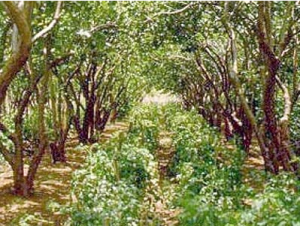Tripura, India Intercropping answer to challenge of long gestation period of rubber plantation
By Jayanta Bhattacharya

Agartala, India , Madhuti Debbarma of Tripura’s Khowai district (India) planted rubber saplings she got free of cost but as the benefits of the plantation will come after seven long years, she was worried about how to make both ends meet during the period.
Now, Debbarma, a resident of Bara Maidan area, has found the answer – intercropping. It is the practice of growing two or more different types of crops on the same agricultural field together.
The 30-year-old woman and her husband now plant cash crops like pineapple along with vegetables such as chilli and cucumber in between the rows of rubber saplings and are generating some additional income.
“The officers of Rubber Board gave us the idea of intercropping. We know that the benefits of rubber plantation will reach us only after seven years. So, we are cultivating vegetables and other cash crops and being able to earn some money for sustenance,” Debbarma said.
The couple plants rubber saplings, provided to them for free by the Rubber Board, and grows other crops on the slopes of hillocks in the Baramura hill range.
“We are trying to promote intercropping among the beneficiaries. The practice of intercropping is rare in Tripura. Hence cash crops like pineapple and coffee along with vegetables like chilli and cucumber etc are encouraged.
“Sugandha Mantri, a plant used in aromatherapy, is also cultivated through intercropping in Tripura. Approximately 5,000 rubber beneficiaries are presently involved in intercropping,” Rubber Board Joint Commissioner Shylaja K said.
She said that people of around 150 colonies in Khowai are also engaged in beekeeping along with the rubber plantation business, which has helped in improving their economic condition.
Shylaja said, “The practice of intercropping and beekeeping in rubber garden is relatively a new concept in the state, though it prevails in Kerala and other countries such as Thailand or Malaysia.”
However, intercropping is helpful only for some time as, when the rubber plant becomes mature, its canopy becomes very thick and sunlight cannot reach the ground, affecting the growth of smaller plants.
Tripura is the second rubber capital of the country after Kerala. The government of the northeastern state initially allowed 1,000,000 hectares of land to be brought under rubber plantation. Later, in view of the increasing demand, an additional 30,000 hectares was allowed for growing rubber.
However, at present 89,000 hectares of land are under rubber cultivation in the state, Shylaja said.
The Automotive Tire manufacturers Association (ATMA), a conglomeration of several tire producers, provides funds to the board to supply rubber saplings to the beneficiaries free of cost, she said.
The intention is to procure natural rubber from inside the country and not depend on imported rubber. Besides ATMA, other agencies such as Tripura Forest Development Plantation Corporation Ltd and Tripura Rehabilitation Plantation Corporation Ltd help in funding the process of breeding and maintenance of the crop.
We are here to share current happenings in the bee industry. Bee Culture gathers and shares articles published by outside sources. For more information about this specific article, please visit the original publish source: Tripura Intercropping answer to challenge of long gestation period of rubber plantation – The Week








